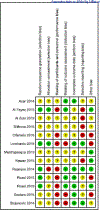Transepithelial Versus Epithelium-Off Corneal Crosslinking for Progressive Keratoconus: Findings From a Cochrane Systematic Review
- PMID: 34048801
- PMCID: PMC8599612
- DOI: 10.1016/j.ajo.2021.05.009
Transepithelial Versus Epithelium-Off Corneal Crosslinking for Progressive Keratoconus: Findings From a Cochrane Systematic Review
Abstract
Purpose: The purpose of this study was to summarize key findings from a systematic review of the effectiveness and safety of transepithelial corneal crosslinking (CXL) compared with epithelium-off CXL for progressive keratoconus.
Design: Cochrane systematic review.
Methods: We included in our review only randomized controlled trials (RCTs) in which transepithelial and epithelium-off CXL had been compared among participants with progressive keratoconus. The primary outcome was keratoconus stabilization based on post-operative maximum keratometry (Kmax). We adhered to Cochrane methods for trial selection, data extraction, risk of bias evaluation, and data synthesis.
Results: Thirteen RCTs with 567 participants (661 eyes) were included; 11 studies compared non-iontophoresis-assisted transepithelial with epithelium-off CXL. Keratoconus stabilization was described as an outcome in 2 studies. The estimated difference in Kmax means (ie, the "mean difference," MD) from meta-analysis of 177 eyes in 5 RCTs indicated that there were no differences between intervention groups in Kmax at 12 months or later (MD: 0.99 diopter [D]; 95% confidence interval: -0.11 to 2.09). Meta-analysis of keratometry and visual acuity outcomes at 12 months or longer after surgery from 2 studies that had compared transepithelial CXL using iontophoresis provided no conclusive evidence of an advantage over epithelium-off CXL.
Conclusions: Lack of precision due to small sample sizes, indeterminate risk of bias due to inadequate reporting, and inconsistency in how outcomes were measured and reported among studies make it difficult to state with confidence whether transepithelial CXL confers an advantage over epithelium-off CXL for patients with progressive keratoconus with respect to stabilization of keratoconus, visual acuity, or patient-reported outcomes based on available data.
Copyright © 2021 Elsevier Inc. All rights reserved.
Figures



Similar articles
-
Transepithelial versus epithelium-off corneal crosslinking for progressive keratoconus.Cochrane Database Syst Rev. 2021 Mar 23;3(3):CD013512. doi: 10.1002/14651858.CD013512.pub2. Cochrane Database Syst Rev. 2021. PMID: 33765359 Free PMC article.
-
Comparison of contact lens-assisted and transepithelial corneal crosslinking with standard epithelium-off crosslinking for progressive keratoconus: 24-month clinical results.J Cataract Refract Surg. 2022 Feb 1;48(2):199-207. doi: 10.1097/j.jcrs.0000000000000732. J Cataract Refract Surg. 2022. PMID: 34174043
-
Efficacy and safety of transepithelial corneal collagen crosslinking surgery versus standard corneal collagen crosslinking surgery for keratoconus: a meta-analysis of randomized controlled trials.BMC Ophthalmol. 2017 Dec 28;17(1):262. doi: 10.1186/s12886-017-0657-2. BMC Ophthalmol. 2017. PMID: 29282020 Free PMC article. Review.
-
Transepithelial versus epithelium-off corneal cross-linking for the treatment of progressive keratoconus: a randomized controlled trial.Am J Ophthalmol. 2015 May;159(5):821-8.e3. doi: 10.1016/j.ajo.2015.02.005. Epub 2015 Feb 19. Am J Ophthalmol. 2015. PMID: 25703475 Clinical Trial.
-
Epithelium-on versus epithelium-off corneal collagen crosslinking for keratoconus: a systematic review and meta-analysis.Graefes Arch Clin Exp Ophthalmol. 2024 Jun;262(6):1683-1692. doi: 10.1007/s00417-023-06287-8. Epub 2023 Nov 8. Graefes Arch Clin Exp Ophthalmol. 2024. PMID: 37938377 Free PMC article.
Cited by
-
Patient experience and repeatability of measurements made with the Pentacam HR in patients with keratoconus.BMC Ophthalmol. 2023 May 8;23(1):201. doi: 10.1186/s12886-023-02930-4. BMC Ophthalmol. 2023. PMID: 37150816 Free PMC article.
-
Comparison of Efficacy and Safety Between Standard, Accelerated Epithelium-Off and Transepithelial Corneal Collagen Crosslinking in Pediatric Keratoconus: A Meta-Analysis.Front Med (Lausanne). 2022 Mar 17;9:787167. doi: 10.3389/fmed.2022.787167. eCollection 2022. Front Med (Lausanne). 2022. PMID: 35372437 Free PMC article.
-
Current clinical practice in corneal crosslinking for treatment of progressive keratoconus in four Nordic countries.Acta Ophthalmol. 2023 Feb;101(1):109-116. doi: 10.1111/aos.15213. Epub 2022 Jul 10. Acta Ophthalmol. 2023. PMID: 35811357 Free PMC article.
-
A comprehensive review on corneal crosslinking.Taiwan J Ophthalmol. 2024 Feb 2;14(1):44-49. doi: 10.4103/tjo.TJO-D-23-00055. eCollection 2024 Jan-Mar. Taiwan J Ophthalmol. 2024. PMID: 38654993 Free PMC article. Review.
-
Reproducibility and Screening Capability of Corneal Epithelial Thickness Measurement for Keratoconus Using Anterior Segment Optical Coherence Tomography.Clin Ophthalmol. 2025 Jun 30;19:2057-2065. doi: 10.2147/OPTH.S528630. eCollection 2025. Clin Ophthalmol. 2025. PMID: 40621428 Free PMC article.
References
-
- Rabinowitz YS. Keratoconus. Surv Ophthalmol. 1998;42(4):297–319. - PubMed
-
- Godefrooij DA, de Wit GA, Uiterwaal CS, Imhof SM, Wisse RP. Age-specific incidence and prevalence of keratoconus: a nationwide registration study. Am J Ophthalmol. 2017;175:169–172. - PubMed
-
- Kennedy RH, Bourne WM, Dyer JA. A 48-year clinical and epidemiologic study of keratoconus. Am J Ophthalmol. 1986;101(3):267–273. - PubMed
-
- Caporossi A, Mazzotta C, Baiocchi S, Caporossi T. Long-term results of riboflavin ultraviolet a corneal collagen cross-linking for keratoconus in Italy: the Siena eye cross study. Am J Ophthalmol. 2010;149(4):585–593. - PubMed
Publication types
MeSH terms
Substances
Grants and funding
LinkOut - more resources
Full Text Sources
Other Literature Sources

